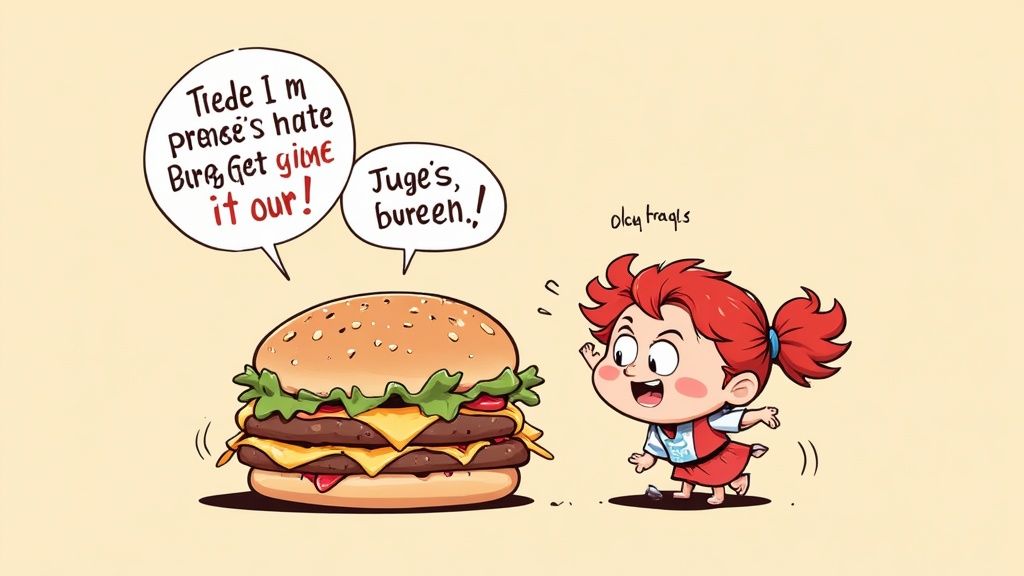Finding Your Brand's True Voice
A distinct brand voice is crucial for standing out. It's the personality infused in your communication, fostering connection and loyalty. This listicle showcases 10 diverse brand voices, deconstructing their strategies so you can craft your own. Learn how brands like Apple, Nike, and Wendy's use their unique voices to resonate with their target audience and build lasting brand recognition. Discover actionable tips to define and implement a voice that attracts your ideal clients and elevates your brand.
1. Apple's Minimalist and Innovative Voice
Apple's brand voice is the epitome of "less is more." It's characterized by simplicity, clarity, and a laser focus on how its products enhance users' lives. Rather than burying customers in technical jargon, Apple communicates with a quiet confidence, emphasizing the transformative power of its technology. This minimalist approach extends to every aspect of their communication, from website copy to product packaging, resulting in a highly recognizable and aspirational brand identity. Their messaging is clean, direct, and often emotionally resonant, mirroring the sleek, minimalist design of their products themselves. This approach resonates deeply with consumers seeking elegant solutions and seamless experiences.

How it Works:
Apple's brand voice centers around a few key principles:
- Simple, clear language: Eliminating jargon and complex sentence structures makes their message accessible to a wider audience.
- Future-focused messaging: They emphasize the possibilities and potential their products unlock, creating a sense of excitement and anticipation.
- Emotionally resonant copy: They connect with consumers on a deeper level by focusing on the feelings their products evoke, rather than just their features.
- Minimalist approach: This extends to every aspect of their communication, reinforcing the idea of elegant simplicity.
- Consistently confident tone: They project an unwavering belief in their products, which inspires trust and confidence in their customers.
Examples of Successful Implementation:
- "Think Different" campaign: This iconic campaign tapped into the desire for individuality and creativity, positioning Apple as a brand for those who challenge the status quo.
- "1,000 songs in your pocket" (iPod messaging): This simple, yet powerful statement perfectly captured the revolutionary nature of the iPod.
- "This changes everything" (iPhone launch): This bold claim instantly communicated the transformative impact of the iPhone.
- "Designed by Apple in California" (product signature): This understated phrase reinforces Apple's commitment to design and quality.
Tips for Implementation:
- Focus on benefits rather than specifications: Highlight how your product or service improves your customers' lives.
- Eliminate unnecessary words: Strive for clarity and conciseness in your messaging.
- Use simple, direct sentences: Make your message easy to understand and digest.
- Create emotional connections through storytelling: Share stories that resonate with your target audience and evoke the desired emotions.
- Maintain consistency across all touchpoints: Ensure your brand voice is consistent across your website, social media, marketing materials, and customer service interactions.
When and Why to Use This Approach:
This voice is particularly effective for businesses offering premium products or services where design, simplicity, and user experience are paramount. It works well for:
- Solopreneurs building service businesses: Differentiate yourself by showcasing the transformative impact of your services, rather than just listing your skills.
- Aspiring creators: Establish a clear and consistent brand identity that resonates with your target audience.
- Career pivoters: Project confidence and expertise in your new field.
- Coaches/consultants: Attract clients who value clarity, simplicity, and impactful solutions.
- Purpose-driven professionals: Communicate your mission and values in a way that inspires and motivates.
Pros:
- Highly recognizable
- Creates a perception of accessibility despite premium pricing
- Builds strong emotional connection with customers
- Supports premium positioning
Cons:
- Can sometimes come across as pretentious
- Difficult to maintain consistency across global markets
- Challenging to replicate without seeming derivative
Popularized By: Steve Jobs, Jonathan Ive, Lee Clow (TBWA\Chiat\Day), Tim Cook
Apple's minimalist and innovative voice deserves its place on this list because it exemplifies the power of simplicity and clarity in building a strong, recognizable brand. It serves as a powerful model for businesses seeking to connect with their audience on an emotional level and create a lasting impression. While achieving this level of minimalist sophistication requires dedication and careful execution, the rewards in terms of brand recognition and customer loyalty are significant.
2. Nike's Empowering and Motivational Voice
Nike has cultivated a brand voice that resonates deeply with its target audience, transcending mere product promotion to become a source of inspiration and motivation. This powerful voice is characterized by its boldness, its directness, and its unwavering belief in human potential. It works by tapping into fundamental desires for self-improvement and achievement, positioning Nike not just as a sportswear company but as a partner in the pursuit of personal greatness. It tells a story of overcoming challenges, pushing boundaries, and achieving the seemingly impossible, a narrative that appeals to both seasoned athletes and those simply striving to be better versions of themselves. Nike’s voice effectively positions the brand as an enabler of athletic achievement and personal growth, encouraging consumers to push their limits.

One of the most distinctive features of Nike's brand voice is its use of second-person direct address. Phrases like "Just Do It" and "Find Your Greatness" speak directly to the individual, creating a sense of personal connection and fostering a feeling of empowerment. This directness is combined with action-oriented messaging and motivational language that spurs consumers to take action and pursue their goals. The brand’s tone is both inclusive and challenging, welcoming everyone to the pursuit of athleticism while simultaneously pushing them beyond their comfort zones. For a deeper dive, you can learn more about Nike's Empowering and Motivational Voice.
Successful implementations of this voice are evident in campaigns like "Just Do It," "Find Your Greatness," and "You Can't Stop Us." The "Dream Crazy" campaign featuring Colin Kaepernick further demonstrates Nike's willingness to take a stand on social issues, aligning the brand with values of courage and perseverance. These campaigns resonate not just with athletes but also with solopreneurs, aspiring creators, career pivoters, coaches/consultants, and purpose-driven professionals who find inspiration in the message of pushing boundaries and pursuing one's passions.
Pros of adopting a similar empowering and motivational voice:
- Creates strong emotional connection: It taps into deep-seated desires for achievement and self-improvement.
- Transcends sports categories: The message of empowerment resonates with a broad audience.
- Appeals to both athletes and aspirational customers: It speaks to both those actively pursuing athletic goals and those who admire the pursuit of excellence.
- Supports premium pricing through emotional value: The brand's inspiring message justifies a higher price point.
Cons to consider:
- Can sometimes feel overly aggressive: The intensely motivational tone might alienate some consumers.
- Risks appearing inauthentic if not backed by authentic brand actions: The message must be consistent with the company's values and actions.
- Challenging to maintain across diverse global markets: Adapting the message while maintaining its core essence requires careful consideration of cultural nuances.
Tips for implementing this voice:
- Create short, impactful statements: Think "Just Do It."
- Focus on overcoming challenges: Highlight stories of resilience and perseverance.
- Use action verbs to drive engagement: Inspire action with words like "run," "jump," "achieve."
- Connect products to emotional outcomes: Position your product or service as a tool for achieving personal goals.
- Maintain consistency while evolving with cultural shifts: Stay true to your core message while adapting to changing societal values.
Nike’s empowering and motivational voice deserves its place on this list because it demonstrates the profound impact a strong brand voice can have on connecting with an audience, building brand loyalty, and driving business success. Its enduring popularity and effectiveness serve as a powerful example for anyone looking to build a brand that inspires and motivates.
3. Wendy's Sassy and Humorous Voice
Wendy's has become a shining example of how a distinctive brand voice can cut through the noise of social media and establish a powerful brand identity. Their approach, characterized by wit, sarcasm, and a healthy dose of edginess, has revolutionized how fast-food chains communicate online. Instead of sterile corporate messaging, Wendy's interacts with followers and competitors alike with a conversational tone, injecting humor and pop culture references into their communications. This creates a relatable, youthful persona that resonates strongly with their target audience, making them feel like they're interacting with a friend rather than a faceless corporation.

This sassy and humorous voice is built on several key features: witty comebacks (particularly in response to customer queries or competitor jabs), real-time engagement with trending topics and user comments, fluency in internet culture and memes, direct call-outs of competitors (often playfully mocking their offerings), a consistently conversational tone, and a strategic use of humor that avoids feeling forced or inauthentic. The success of this strategy is undeniable. It generates high engagement and shareability, leading to increased brand awareness and a loyal online community. Their bold approach also garners significant free media coverage, amplifying their message organically. Think of the #NuggsForCarter campaign where a user’s plea for free nuggets went viral, or their participation in National Roast Day, or their ongoing, often humorous, “Fresh, Never Frozen” beef messaging battles with McDonald’s. These are all testaments to the power of a well-crafted and consistently applied brand voice.
For solopreneurs, creators, career pivoters, coaches, and purpose-driven professionals, Wendy's approach offers valuable lessons. It demonstrates that differentiating yourself in a crowded market requires more than just a good product or service; it requires a personality that resonates with your audience. By injecting humor and authenticity into your brand voice, you can forge stronger connections with potential clients and customers.
However, this approach isn't without its risks. The edgy nature of Wendy's voice can sometimes lead to controversy or backlash. Maintaining this tone consistently across a growing social media team can also be challenging, and it certainly isn't appropriate for all situations, especially crisis communications. Furthermore, humor can be subjective and what works in one culture might not translate well globally, making scaling this approach internationally complex.
If you're considering adopting a similar voice for your brand, here are some actionable tips:
- Know when to be funny and when to be serious: Humor is a powerful tool, but it's not always appropriate. Be mindful of the context and avoid making light of sensitive topics.
- Establish clear voice guidelines and boundaries: Document your brand voice’s personality, tone, and acceptable levels of humor and sarcasm. This helps maintain consistency across your team.
- Be prepared to respond quickly: Real-time engagement is key to this approach. Have a dedicated team ready to monitor and respond to comments and mentions promptly.
- Train your social media team thoroughly: Ensure everyone on your team understands the nuances of your brand voice and can apply it consistently.
- Monitor sentiment carefully: Track public reaction to your posts and be prepared to adjust your approach if necessary. Pay attention to feedback and be willing to learn from mistakes.
Wendy's success story, largely driven by individuals like former social media manager Amy Brown, the VML agency, and even nugget enthusiast Carter Wilkerson, underscores the impact a distinct and consistent brand voice can have. While it's crucial to adapt the approach to your specific brand and target audience, the core principles of authenticity, humor, and engagement offer a powerful recipe for standing out in today's digital landscape.
4. Dove's Authentic and Empathetic Voice
Dove has carved a unique space in the beauty industry by cultivating a brand voice centered around authenticity, empathy, and celebrating real beauty. Instead of adhering to traditional beauty advertising tropes, Dove speaks directly to the insecurities and pressures many face, fostering a sense of connection and belonging. This approach works by challenging conventional beauty standards, promoting body positivity, and emphasizing self-acceptance. This resonates deeply with consumers who are tired of unrealistic portrayals and crave genuine connection.
How it works:
Dove's messaging consistently focuses on building confidence and promoting a broader definition of beauty. They achieve this by using warm, inclusive language, showcasing diversity in their campaigns, and backing their claims with research and initiatives that tackle the root causes of low self-esteem. This creates a virtuous cycle where consumers feel seen and understood, leading to increased brand loyalty and positive word-of-mouth marketing.
Examples of successful implementation:
- Real Beauty campaign: This groundbreaking campaign featured real women, not models, in their underwear, challenging the narrow definition of beauty perpetuated by the media.
- Real Beauty Sketches: This campaign used an FBI-trained forensic artist to draw portraits of women based on their own descriptions and then based on descriptions from strangers. The stark contrast highlighted how self-criticism can distort our self-image.
- Self-Esteem Project: This long-term initiative provides educational resources and workshops to help young people develop a positive body image and build self-esteem.
- #ShowUs campaign with Getty Images: This collaboration created a collection of over 10,000 images showcasing diverse women and non-binary individuals, challenging the limited and often stereotypical representation in stock photography.
Actionable Tips for Your Brand:
- Focus on authenticity in all communications: Be genuine and transparent in your messaging. Avoid empty platitudes and focus on real issues that resonate with your target audience.
- Use real customers rather than models: Showcasing real people adds credibility and fosters a sense of relatability.
- Back messaging with concrete actions and initiatives: Don't just talk the talk; walk the walk. Support your brand message with tangible actions that demonstrate your commitment.
- Create guidelines for maintaining an empathetic tone: Ensure all communications, from social media posts to customer service interactions, reflect your brand's empathetic values.
- Listen to community feedback: Pay attention to what your audience is saying and be responsive to their needs and concerns.
When and Why to Use This Approach:
This approach is particularly effective for brands targeting audiences who value authenticity, inclusivity, and social responsibility. It's ideal for:
- Solopreneurs building service businesses: Differentiate yourself by showcasing your genuine care for your clients and building a community around shared values.
- Aspiring Creators: Establish a strong personal brand by being authentic and vulnerable in your content.
- Career Pivoters: Communicate your values and connect with potential employers on a deeper level.
- Coaches/Consultants: Attract clients who align with your values and build trusting relationships.
- Purpose-Driven Professionals: Infuse your work with meaning and connect with your audience on an emotional level.
Pros:
- Creates deep emotional connection with target audience
- Differentiates from traditional marketing approaches
- Supports premium positioning through value alignment
- Generates word-of-mouth and earned media
Cons:
- Requires genuine organizational commitment to avoid appearing inauthentic
- Challenging to balance with product promotion
- Must continually evolve with changing social perspectives
Popularized By: Ogilvy & Mather agency, Fernando Machado (former Global Brand VP), Unilever's Sustainable Living Plan
Dove's authentic and empathetic voice deserves its place on this list because it demonstrates the power of values-driven marketing. By focusing on genuine connection and challenging industry norms, Dove has built a loyal following and become a leading voice in the movement for positive self-image. While replicating their success requires careful consideration and a deep commitment to authenticity, the potential rewards for building a brand on empathy and genuine connection are immense.
5. Spotify's Playful and Data-Driven Voice
Spotify has mastered the art of blending data with delight, creating a brand voice that feels both intimately personal and broadly relevant. This approach leverages user data not just for targeted advertising, but to build genuine connections and foster a sense of community. It's a powerful example of how data, when used thoughtfully, can enhance, not detract from, a brand's personality. This makes it particularly relevant for solopreneurs, creators, and career pivoters looking to build a strong, differentiated brand.
How it Works: Spotify’s strategy centers on transforming cold, hard data into warm, engaging narratives. By analyzing listening habits, playlist creations, and other user interactions, they craft communications that resonate on an individual level while tapping into wider cultural trends. This data-driven approach allows them to personalize messages, curate relevant content, and even inject humor based on user behavior.
Examples of Successful Implementation:
- Wrapped (Annual User Data Campaigns): Perhaps the most iconic example, Wrapped presents users with a personalized summary of their listening habits throughout the year. This gamified approach encourages sharing on social media, generating massive organic reach and reinforcing Spotify's position as a cultural touchstone.
- Billboard Campaigns: Spotify uses data to identify quirky playlist names and features them on outdoor billboards, creating a sense of shared amusement and demonstrating a deep understanding of its user base. This translates seemingly mundane data points into relatable, real-world humor.
- Personalized Discovery Weekly Communications: By analyzing individual listening habits, Spotify curates personalized playlists and promotes them with tailored messaging. This reinforces the value proposition of personalized music discovery and strengthens user engagement.
- Culturally-Relevant Playlist Curation: Spotify leverages data to identify trending genres, artists, and moods, creating playlists that cater to specific cultural moments and events. This demonstrates a keen understanding of the cultural landscape and positions Spotify as a tastemaker.
Tips for Implementing a Data-Driven and Playful Voice:
- Use data to create personal connections: Don't just target ads; craft narratives and experiences that resonate with individual users based on their behavior and preferences.
- Stay culturally relevant without trying too hard: Leverage data to identify genuine trends and incorporate them organically, avoiding forced or inauthentic attempts to be "trendy."
- Balance humor with respect for privacy: While playful use of data can be engaging, ensure user privacy is paramount and avoid anything that could be perceived as invasive or creepy.
- Create a framework for consistent voice across touchpoints: Ensure your playful and data-driven approach is applied consistently across all communication channels, from social media to email marketing.
- Leverage current events and trends appropriately: Tie your messaging to relevant events and cultural moments to enhance relevance and engagement.
Pros:
- Creates a sense of personal connection at scale.
- Generates high engagement and sharing.
- Differentiates from competitors.
- Makes complex technology feel approachable.
Cons:
- Data-driven approach requires sophisticated analytics.
- Balance between clever and invasive can be delicate.
- Maintaining cultural relevance requires constant vigilance.
Popularized By: Daniel Ek (CEO), In-house creative team, Agency partners including Who Wot Why (www.spotify.com)
Why Spotify's Approach Deserves a Spot on this List:
Spotify's voice is a masterclass in leveraging data not just for marketing, but for building a vibrant brand community. It demonstrates how data can be used creatively and ethically to personalize experiences, foster connections, and ultimately drive business growth. This is particularly valuable for those building a service-based business, creating online content, or pivoting careers, as it provides a roadmap for building a strong, differentiated brand in a crowded marketplace. For coaches and consultants, this model showcases how to connect with target audiences on a deeper level, creating more meaningful relationships that translate into tangible results.
6. Mailchimp's Quirky and Helpful Voice
Mailchimp, the email marketing platform, stands out in the often-dry B2B landscape with its distinctive brand voice. This voice expertly balances quirky personality with practical helpfulness, making complex marketing concepts accessible while injecting a memorable personality. It's a prime example of how a well-crafted voice can differentiate a brand, especially for solopreneurs, aspiring creators, career pivoters, coaches/consultants, and purpose-driven professionals seeking to stand out.
This approach hinges on communicating with a distinctive, slightly offbeat tone while still delivering clear, actionable guidance. Think conversational language and strategic humor interwoven with simplified technical explanations. This consistent personality persists across all their touchpoints, from website copy to social media posts and even error messages.
Features of Mailchimp's Brand Voice:
- Conversational Language: Mailchimp speaks to users like a friend, avoiding jargon and technical complexities.
- Strategic Use of Humor: Humor is used sparingly but effectively to create a memorable and engaging experience.
- Simplified Technical Explanations: Complex topics are broken down into easy-to-understand language, empowering users of all technical levels.
- Consistent Personality Across Touchpoints: The quirky, helpful voice is maintained across their website, emails, social media, and even in-app messaging.
- Balance of Quirky and Professional: Mailchimp manages to be approachable without sacrificing professionalism.
Examples of Mailchimp's Voice in Action:
- High Five Animations After Campaign Sends: A small, playful touch that celebrates user accomplishments and reinforces positive associations with the platform.
- Freddie the Mascot's Personality Integration: Freddie, the Mailchimp chimpanzee mascot, embodies the brand's playful yet helpful personality.
- "Did You Mean Mailchimp?" Campaign: This clever campaign, developed by Droga5, leveraged misspellings of the brand name to create humorous and memorable content.
- Knowledge Base Articles: Even within helpful documentation, Mailchimp maintains its distinct voice, making learning enjoyable.
Pros of Adopting a Similar Voice:
- Makes a Technical Product More Approachable: The friendly tone removes the intimidation factor often associated with technical platforms.
- Creates Memorable Brand Personality in B2B Space: In a sea of corporate jargon, Mailchimp’s personality shines through.
- Builds Trust Through Accessibility: The approachable voice fosters a sense of trust and connection with users.
- Supports Self-Service Model Through Clear Communication: Clear and engaging communication empowers users to navigate the platform independently.
Cons to Consider:
- Can Risk Appearing Unprofessional to Certain Business Segments: The quirky tone may not resonate with all audiences, particularly in very formal industries.
- Challenging to Scale Internationally: Humor and tone can be difficult to translate and adapt across different cultures.
- Difficult to Maintain Consistently as Company Grows: As a company expands, ensuring consistent voice across all teams and content can be a challenge.
Tips for Implementing a Quirky and Helpful Voice:
- Establish Clear Voice Guidelines with Examples: Document the specific characteristics of your brand voice and provide concrete examples to guide content creation.
- Use Humor Strategically, Not Gratuitously: Humor should enhance the message, not distract from it.
- Simplify Complex Concepts Without Being Condescending: Break down technical jargon into plain language while respecting your audience's intelligence.
- Test Your Voice with Target Audience Segments: Gather feedback to ensure your voice resonates with your ideal customers.
- Train All Content Creators Thoroughly: Everyone creating content should be well-versed in the brand voice guidelines to ensure consistency.
Popularized By: Ben Chestnut (Co-founder), Kate Kiefer Lee (Former Content Director), Droga5 agency for "Did You Mean Mailchimp?" campaign
Mailchimp's success demonstrates the power of a well-defined brand voice. By strategically balancing quirkiness and helpfulness, they've created a memorable brand that resonates deeply with their target audience. This approach is particularly valuable for individuals and businesses seeking to establish a unique identity in a crowded marketplace. If you’re looking to differentiate yourself and create a more engaging brand experience, consider adopting a similar approach, tailored to your own personality and target audience.
7. Patagonia's Authentic and Activist Voice
Patagonia stands out as a shining example of a brand that deeply intertwines its values with its voice. Their commitment to environmental and social activism isn't just a marketing tactic; it's woven into the fabric of their company. This resonates with customers who prioritize these same values, fostering a strong sense of community and loyalty. Patagonia communicates with authenticity, conviction, and a clear sense of purpose that transcends mere product promotion. Their straightforward, sometimes blunt, language cuts through the noise, reinforcing their commitment to environmental and social responsibility. This approach establishes them as more than just an outdoor apparel company; they become a platform for change.

This activist voice manifests in various ways, from their "Don't Buy This Jacket" campaign challenging consumerism to their "The President Stole Your Land" advocacy directly confronting political decisions impacting the environment. The Worn Wear program, promoting repair and reuse over new purchases, further solidifies their commitment to sustainability. Their messaging often takes an educational tone, informing customers about environmental issues and inspiring them to take action. Patagonia’s environmental grant program communications further emphasize this commitment, showcasing how they invest in grassroots environmental organizations. You can learn more about Patagonia's Authentic and Activist Voice.
Features of Patagonia's Voice:
- Environmental advocacy: Their messaging consistently champions environmental protection and sustainability.
- Straightforward, no-nonsense language: They communicate directly and honestly, avoiding marketing jargon.
- Value-driven messaging: Their communications center around their core values, creating a strong brand identity.
- Storytelling approach: They use compelling narratives to connect with their audience on an emotional level.
- Educational tone: They provide information about environmental issues, empowering consumers to make informed choices.
- Calls to action beyond purchases: They encourage customers to engage in activism and environmental stewardship.
Pros:
- Creates a strong community of like-minded customers: This fosters brand loyalty and advocacy.
- Differentiates from competitors: Their strong values set them apart in a crowded market.
- Builds deep brand loyalty: Customers connect with the brand on a deeper level, leading to long-term relationships.
- Supports premium pricing through value alignment: Consumers are willing to pay more for products aligned with their values.
Cons:
- Can alienate potential customers with different political views: Their strong stance can be polarizing.
- Requires thorough organizational alignment: The entire company must embody the brand's values.
- Must consistently back words with actions: Any discrepancy between words and actions can damage credibility.
Tips for Implementing an Authentic and Activist Voice:
- Connect product features directly to values: Explain how your product supports your chosen cause.
- Use storytelling to illustrate impact: Share real-life examples of how your brand makes a difference.
- Back messaging with concrete actions: Demonstrate your commitment through tangible initiatives.
- Maintain consistency between words and corporate behavior: Ensure your actions align with your stated values.
- Focus on education alongside promotion: Empower your audience with knowledge and inspire them to take action.
Patagonia's approach provides a powerful model for solopreneurs, creators, career pivoters, coaches, consultants, and purpose-driven professionals seeking to build a brand with genuine impact. This approach is particularly effective for those targeting audiences who prioritize values and seek brands that align with their worldview. By embracing authenticity, conviction, and a clear sense of purpose, you can forge deep connections with your target audience, differentiate yourself from competitors, and build a brand that stands for something more than just profit.
8. Dollar Shave Club's Irreverent and Direct Voice
Dollar Shave Club (DSC) provides a prime example of how a distinctive brand voice can disrupt an established industry. They achieved this not just by offering a convenient and affordable alternative to traditional razor subscriptions, but also by speaking to their target audience in a way no other brand dared to. This irreverent and direct voice, characterized by humor, candor, and even occasional mild profanity, resonated deeply with their customer base and quickly propelled the brand to success. It’s a powerful demonstration of the impact a carefully crafted voice can have on brand recognition and customer loyalty. This approach is particularly relevant for solopreneurs, aspiring creators, career pivoters, coaches/consultants, and purpose-driven professionals seeking to differentiate themselves in a crowded marketplace.
This voice works by cutting through the typical marketing jargon and speaking directly to the customer's needs and frustrations. Instead of focusing on hyperbolic claims and polished imagery, DSC utilizes conversational language, self-deprecating humor, and straightforward value propositions. They address bodily functions directly and aren't afraid to poke fun at themselves or the industry. This creates a sense of authenticity and builds a connection with the consumer, making them feel like they're part of an inside joke.
Features of this voice include:
- Conversational language: Think talking to a friend, not reading a corporate press release.
- Strategic irreverence: Humor and a touch of rebelliousness, carefully calculated not to alienate.
- Direct address: Speaking directly to the "you," the customer.
- Self-deprecating humor: Not taking themselves too seriously.
- Straightforward value propositions: Clear and concise explanations of the benefits.
- Occasional mild profanity: Used sparingly for impact and to reinforce the "anti-establishment" vibe.
Pros:
- Highly memorable and distinctive: DSC's voice is instantly recognizable.
- Creates a sense of authenticity: Customers feel a genuine connection with the brand.
- Breaks through marketing clutter: Cuts through the noise of traditional advertising.
- Appeals strongly to the target demographic: Resonates with a specific audience seeking a no-nonsense approach.
Cons:
- Not universally appealing: May alienate some demographics or cultures.
- Difficult to maintain as brand matures: Finding the balance between irreverence and professionalism can be challenging as a company grows.
- Doesn't translate well to all international markets: Humor and slang are often culture-specific.
- Risk of seeming juvenile: If not executed carefully, it can come across as immature or unprofessional.
Examples of successful implementation:
- Their iconic "Our Blades Are F***ing Great" launch video, which went viral and put DSC on the map.
- Email marketing campaigns with conversational, attention-grabbing subject lines.
- Product descriptions that address bodily functions directly, in a humorous and relatable way.
- Social media engagement that maintains a direct, humorous, and often self-aware tone.
Tips for implementing this voice:
- Understand your audience's tolerance for irreverence: Research and test different levels of humor.
- Create clear guidelines for appropriate humor: Ensure consistency and avoid crossing the line.
- Maintain consistency across all customer touchpoints: From website copy to social media, the voice should be consistent.
- Know when to be serious: Balance humor with genuine information and customer service.
- Test reception across demographics: Gather feedback to ensure the voice resonates with your target audience.
Learn more about Dollar Shave Club's Irreverent and Direct Voice
Dollar Shave Club’s approach deserves a place on this list because it exemplifies the power of a unique and authentic brand voice. It proves that connecting with your audience on a human level, even with a bit of edge, can be incredibly effective. Popularized by founder Michael Dubin and co-founder Mark Levine, and later acquired by Unilever, DSC's voice shows how a well-defined brand personality can disrupt an industry and build a loyal following. It's a valuable lesson for anyone looking to create a brand that stands out from the crowd.
9. Innocent Drinks' Playful and Conversational Voice
Innocent Drinks has carved a unique niche in the often-serious beverage industry by adopting a remarkably playful and conversational brand voice. Imagine chatting with a friendly, slightly quirky person – that's the essence of Innocent's communication style. They use casual language, gentle, often self-deprecating humor, and a childlike sense of wonder to connect with their audience. This personality permeates their packaging, advertising, social media, and even customer service, making consumers feel like they're interacting with real people, not a faceless corporation. This approach has been instrumental in their success, demonstrating the power of a distinct and engaging brand voice.
How it Works:
Innocent Drinks' voice hinges on creating a sense of intimacy and approachability. It's about breaking down the corporate wall and inviting customers into a lighthearted conversation. This is achieved through several key features:
- Casual, Conversational Language: They use everyday language, avoiding jargon and technical terms, opting for phrases you'd hear in a friendly chat.
- Childlike Wonder and Playfulness: A sense of innocent curiosity and lightheartedness pervades their messaging, often incorporating puns, jokes, and whimsical imagery.
- Self-Deprecating Humor: They aren't afraid to poke fun at themselves, adding to the authentic and relatable feel.
- Hand-drawn Visual Elements: Their packaging often features charming, hand-drawn illustrations, further enhancing the personal touch.
- Unexpected Packaging Copy: Look closely at an Innocent bottle and you'll likely find witty anecdotes, quirky questions, or even mini-stories.
- Transparent Communication: They're open about their ingredients and processes, building trust and reinforcing their honest, down-to-earth image.
Examples of Successful Implementation:
- On-package conversations with customers: Innocent often uses their packaging to directly address consumers, asking questions, telling jokes, or simply sharing a thought.
- The Big Knit campaign communications: This annual charity campaign, where people knit little hats for Innocent bottles, is communicated with the brand's signature playful tone, generating enormous engagement.
- Banana phone customer service: Their playful approach extends to customer service, offering a "banana phone" hotline, adding a touch of whimsy to the experience.
- Innocent Village Fete event messaging: Their event communications mirror their overall brand voice, creating a cohesive and memorable experience.
Tips for Implementing This Approach:
- Write as you speak: Imagine you're talking to a friend – that's the tone to aim for.
- Read copy aloud to test naturalness: This helps ensure your writing sounds conversational and avoids a stiff, corporate feel.
- Create detailed voice guidelines with examples: This ensures consistency across all communication channels.
- Incorporate voice into all customer touchpoints: From your website to your social media to your email newsletters, maintain a consistent voice.
- Balance playfulness with product information: While being playful is key, ensure you still provide essential product details clearly and concisely.
When and Why to Use This Approach:
This approach is particularly effective for brands targeting audiences who appreciate authenticity and connection. It works well for businesses that want to differentiate themselves from more corporate competitors, especially in industries often perceived as serious or stuffy. For solopreneurs, creators, and purpose-driven professionals, this voice can humanize your brand, build trust, and foster a loyal following. It can also be highly effective for coaches and consultants seeking to create a more approachable and relatable image.
Pros:
- Creates a strong emotional connection with customers
- Highly distinctive in a crowded market
- Supports premium pricing by justifying perceived value
- Makes health-focused products more approachable and less intimidating
Cons:
- Can seem too cute or precious for some audiences
- Risk of seeming insincere after corporate acquisition (as happened with Coca-Cola)
- Challenging to maintain authenticity as the brand scales
Popularized By: Richard Reed, Adam Balon, and Jon Wright (Founders), Dan Germain (Head of Brand and Creative), Coca-Cola (majority stakeholder since 2013)
This item deserves its place on the list because it showcases how a unique and consistently applied brand voice can be a powerful differentiator and driver of business success. Innocent Drinks has effectively leveraged its playful and conversational tone to build a strong brand identity, foster deep customer loyalty, and ultimately, sell more smoothies. They offer a compelling example for anyone seeking to create a brand that resonates with its audience on a personal level.
10. Old Spice's Absurd and Confident Voice
Old Spice provides a prime example of how a seemingly outdated brand can completely reinvent itself through a distinctive and memorable brand voice. Their approach hinges on a carefully crafted blend of absurdist humor, hyper-masculine exaggeration, and self-aware ridiculousness, all delivered with unwavering confidence. This unique voice not only revitalized their image but also resonated across demographics, appealing to both their target male audience and the women who often purchase their products.
This strategy works by disrupting conventional marketing tropes in the men's personal care industry. Instead of relying on traditional notions of masculinity, Old Spice embraces the outlandish and unexpected. Non-linear storytelling, rapid-fire delivery, and a consistent character voice further enhance the absurdity, making their campaigns instantly recognizable and highly shareable.
Examples of Successful Implementation:
- The Man Your Man Could Smell Like campaign: This iconic campaign featuring Isaiah Mustafa perfectly exemplifies Old Spice's absurdist humor and hyper-masculine exaggeration. The rapid transitions, over-the-top scenarios, and direct address to the camera created a memorable and viral sensation.
- Social Media Engagement: Old Spice continues to leverage this voice on social media, responding to comments and engaging with followers in character, further solidifying the brand persona. Their personalized video responses, like those created during the initial campaign's success, demonstrate a commitment to interacting with their audience on their own absurd terms.
- Mom Song campaign: Recognizing the significant influence of female purchasers, Old Spice cleverly targeted mothers with the "Mom Song" campaign, acknowledging their role in the purchasing decision while maintaining the brand's signature humor.
Tips for Implementing an Absurd and Confident Voice:
- Commit fully to the absurdity: Don't be afraid to push boundaries and embrace the unexpected. The key is to be genuinely funny and avoid forced or contrived humor.
- Maintain self-awareness in exaggerated claims: Old Spice's humor works because it acknowledges the absurdity of its own pronouncements. This self-awareness prevents the brand from seeming arrogant or out of touch.
- Create detailed character guidelines: Consistency is crucial. Develop clear guidelines for the character's voice, tone, and mannerisms to ensure a unified brand experience across all platforms.
- Test humor with target audience: What one group finds funny, another might find offensive or simply not amusing. Thoroughly test your humor with your target audience to ensure it resonates.
- Balance absurdity with product benefits: While humor is central to Old Spice's approach, they never lose sight of their product benefits. Ensure that the absurdity complements, rather than overshadows, the value proposition of your product or service.
Pros:
- Transforms dated brand perception
- Appeals across demographics
- Highly memorable and shareable
- Creates strong brand recognition
Cons:
- Risk of humor becoming stale over time
- Challenging to translate globally (humor is often culturally specific)
- Difficult to apply consistently across all communications
Popularized By: Wieden+Kennedy agency, Isaiah Mustafa (Old Spice Guy), Terry Crews (campaign spokesman), Procter & Gamble marketing team
Why this deserves a place on the list:
Old Spice's success demonstrates the power of a well-defined and consistently executed brand voice. This approach is particularly relevant for solopreneurs, aspiring creators, and career pivoters looking to differentiate themselves in a crowded market. By embracing a distinct and memorable voice, you can cut through the noise and establish a strong brand identity that resonates with your target audience. Coaches and consultants can also leverage this strategy to attract the right clients by showcasing personality and creating a more engaging brand experience. For purpose-driven professionals, a distinct voice can help amplify their message and connect with others who share their values. While this approach may not be suitable for every brand, Old Spice's success provides valuable insights into the potential of embracing absurdity and confidence to achieve remarkable results.
10 Brand Voice Comparison Matrix
| Brand Voice | 🔄 Complexity | ⚡ Resources | 📊 Outcome | 💡 Use Cases | ⭐ Advantages |
|---|---|---|---|---|---|
| Apple's Minimalist and Innovative Voice | Moderate – streamlined yet requires global consistency | High – robust creative input and design precision | Builds premium positioning with strong emotional resonance | Premium tech & innovative product campaigns | Recognizable, clear, and emotionally resonant |
| Nike's Empowering and Motivational Voice | Moderate to High – action-oriented tone with direct engagement | High – robust narrative and endorsement investment | Drives strong emotional engagement and aspirational appeal | Sports and lifestyle marketing | Bold, inspiring, and transcends category boundaries |
| Wendy's Sassy and Humorous Voice | High – real-time engagement and witty, reactive communications | Moderate – agile social media monitoring and creative team | Generates viral engagement and high shareability | Social media campaigns and event marketing | Unique, engaging, and memorable tone |
| Dove's Authentic and Empathetic Voice | Moderate to High – requires careful balance of authenticity and inclusivity | High – sustained investment in genuine, value-driven initiatives | Deep emotional connection with differentiated market positioning | Beauty, self-esteem, and cause-related promotions | Genuine, supportive, and empathetic messaging |
| Spotify's Playful and Data-Driven Voice | Moderate – combining data insights with creative, personalized messaging | High – integration of advanced analytics with cultural creativity | Enhances customer retention through personalized, engaging content | Digital engagement and music streaming campaigns | Culturally relevant, approachable, and personalized |
| Mailchimp's Quirky and Helpful Voice | Moderate – balancing offbeat tone with professional clarity | Moderate – consistent guidelines and creative execution | Improves product accessibility and builds user trust | B2B communications and self-service platforms | Memorable, accessible, and simplifies complex topics |
| Patagonia's Authentic and Activist Voice | Moderate to High – aligning messaging closely with core values | High – continuous commitment to sustainability and value-driven campaigns | Fosters a loyal, values-based community and market positioning | Sustainability and cause-related marketing | Purpose-driven, authentic, and community-building |
| Dollar Shave Club's Irreverent and Direct Voice | Low to Moderate – straightforward tone with risk management | Low – relies on clear, edgy creative guidelines | Establishes a distinctive and candid brand identity | Direct-to-consumer and disruptive marketing | Bold, candid, and effective at breaking through marketing clutter |
| Innocent Drinks' Playful and Conversational Voice | Moderate – requires natural, consistent friendly tone | Moderate – creative focus on approachable and human-centered language | Creates a strong brand personality with engaging, friendly communications | Food and beverage with a human touch | Approachable, human, and uniquely distinctive |
| Old Spice's Absurd and Confident Voice | High – maintaining a consistent, absurd tone across diverse channels | High – intensive creative effort for memorable, boundary-pushing campaigns | Revitalizes legacy brand image and achieves high memorability | Rebranding efforts and humorous product launches | Bold, captivating, and transformative in brand perception |
Crafting Your Own Authentic Brand Voice
From Apple's minimalist innovation to Old Spice's absurd confidence, these brand voice examples demonstrate the impact of a clearly defined personality. The key takeaway is that your brand voice isn't just what you say, it's how you say it. By understanding your target audience, core values, and unique offering, you can craft a voice that resonates deeply and forges genuine connections. Mastering these concepts is crucial for differentiation in a crowded market, attracting the right clients, and building a loyal following who believe in your brand. This authenticity fosters stronger relationships and ultimately drives more meaningful engagement with your audience, turning casual followers into passionate advocates.
Remember, finding your true voice takes time and experimentation. Use these examples as inspiration, explore different tones and styles, and don't be afraid to let your brand's personality shine through. Ready to define and refine your brand voice? Henri Den can help you clarify your message and connect with your ideal audience. Explore the power of a compelling brand narrative at Henri Den.






